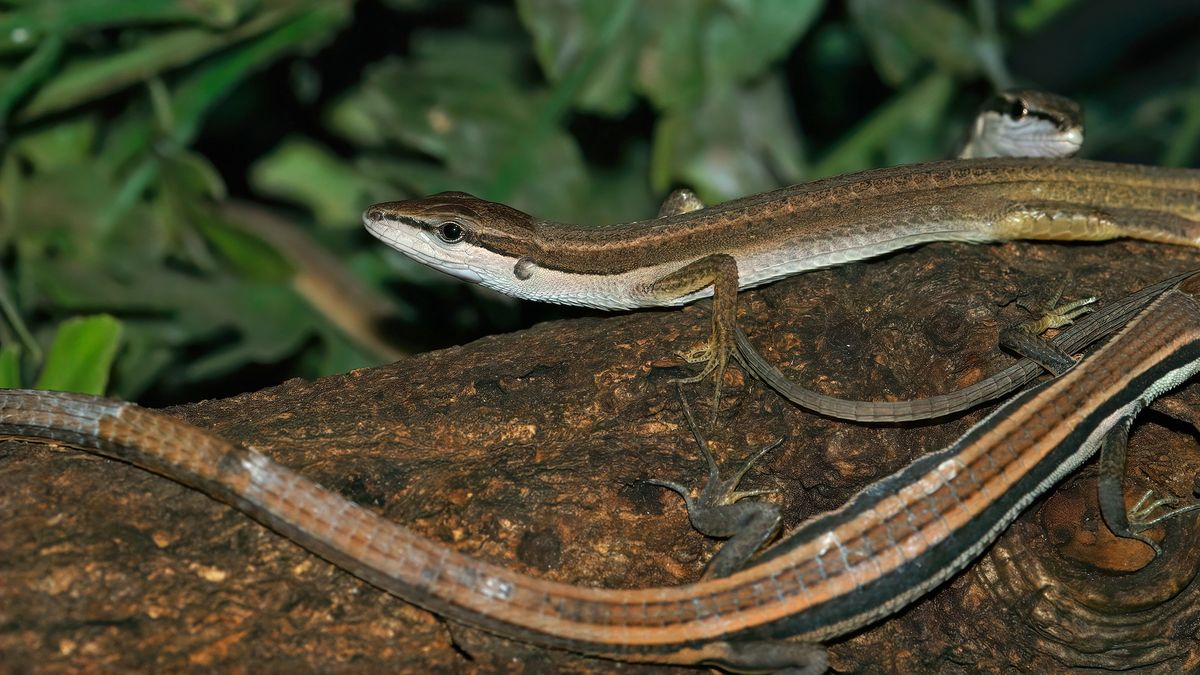Lemurs, lizards, whales — all are famed for their tails in some way. But which animal has the longest tail of all?
In proportion to their bodies, grass lizards have the longest tails of any known living animal. The tails of these small, lightweight lizards are two to three times the length of their torsos, Tommy Owens, a manager in the department of birds and ectotherms (cold-blooded animals) at the Dallas Zoo, told Live Science. For instance, long-tailed grass lizards (Takydromus sexlineatus), a member of this family, can grow up to 1 foot (30 centimeters) long, but their bodies are only 2 to 3 inches (5 to 8 cm) long — the rest is all tail.
The lizards, which are native to Southeast Asia, China and southern Russia, use their long tails to balance on tall grass blades or on tree branches. “You could think of it as the long beam that people walking across a tightrope would carry,” Owens said. “They can use it when they leap from limb to limb for stability. But they can also move from a higher limb to a lower limb by dragging that long tail across the upper limb and lowering themselves slowly to a lower limb.”
Using their tails to slip through trees also helps grass lizards avoid predators, Owens said. But like many other lizards, grass lizards can detach their tails if a predator grabs hold. Losing their tails leaves them somewhat less agile, so the lizards spend the next few months laying low while they regrow their tails, sticking to short-distance foraging rather than ranging across their full territory.
In terms of absolute tail length, thresher sharks take the cake, said Jay Bradley, curator of the Blue Wonders exhibits at the National Aquarium in Baltimore. Thresher sharks (genus Alopias) are migratory species and use their tails primarily for propulsion. But they also use the long upper section of their tail fin, which can grow up to 10 feet (3 meters) long, to hunt.
Related: Do wolves wag their tails?
“Thresher sharks feed on schooling prey (i.e. small fishes, etc.). They swim through these bait balls and use their tails to stun their prey and then swim around to eat the immobilized fish,” Kady Lyons, a research scientist at the Georgia Aquarium, told Live Science in an email.
This hunting behavior has only been documented on video within the last two decades, Bradley said. “They swim up on a school of fish, and then they stop and put down their pectoral fins,” Bradley told Live Science. “Then their tail comes up over their head, and they kind of do this whipping motion and basically stun small prey with a whipping action.”
An honorable mention in both “longest tail” categories goes to a family of stingrays known as whiptail rays, whose tails can be up to three times as long as their disc-shaped bodies. Researchers don’t often measure the length of the rays’ tails because predators can easily bite part of the tail off, Bradley said. But as an example, leopard whiptail rays (Himantura leoparda) can grow up to 4 feet (1.2 m) wide and 13 feet (4 m) long, including their tails, according to the Seattle Aquarium. The bottom-dwelling rays use their tails for stability when swimming and for defense; when a predator attacks from above, the rays can whip their tails up and strike the hunter with a venomous barb.


